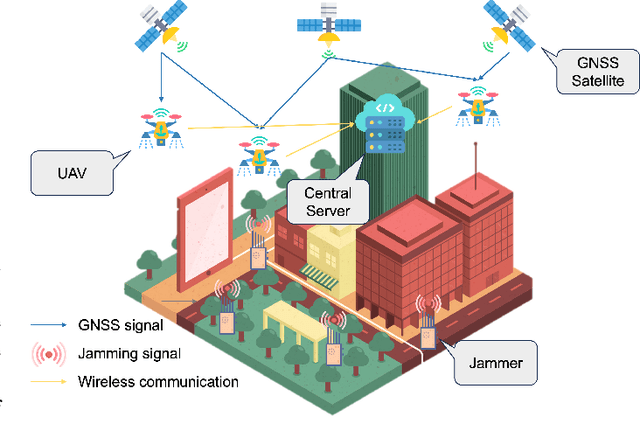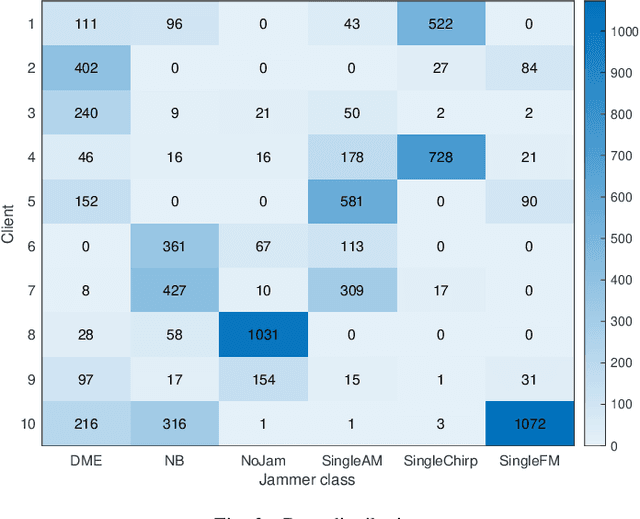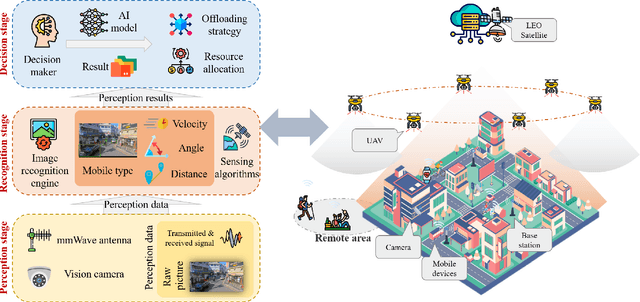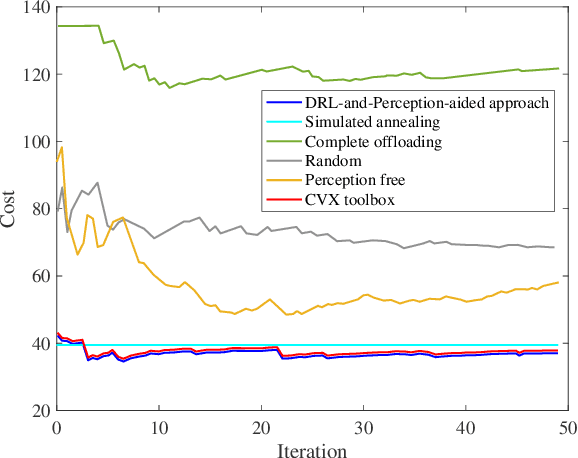Ziqiang Ye
ACSNet: A Deep Neural Network for Compound GNSS Jamming Signal Classification
Apr 15, 2025Abstract:In the global navigation satellite system (GNSS), identifying not only single but also compound jamming signals is crucial for ensuring reliable navigation and positioning, particularly in future wireless communication scenarios such as the space-air-ground integrated network (SAGIN). However, conventional techniques often struggle with low recognition accuracy and high computational complexity, especially under low jamming-to-noise ratio (JNR) conditions. To overcome the challenge of accurately identifying compound jamming signals embedded within GNSS signals, we propose ACSNet, a novel convolutional neural network designed specifically for this purpose. Unlike traditional methods that tend to exhibit lower accuracy and higher computational demands, particularly in low JNR environments, ACSNet addresses these issues by integrating asymmetric convolution blocks, which enhance its sensitivity to subtle signal variations. Simulations demonstrate that ACSNet significantly improves accuracy in low JNR regions and shows robust resilience to power ratio (PR) variations, confirming its effectiveness and efficiency for practical GNSS interference management applications.
Optimizing Radio Access Technology Selection and Precoding in CV-Aided ISAC Systems
Oct 14, 2024Abstract:Integrated Sensing and Communication (ISAC) systems promise to revolutionize wireless networks by concurrently supporting high-resolution sensing and high-performance communication. This paper presents a novel radio access technology (RAT) selection framework that capitalizes on vision sensing from base station (BS) cameras to optimize both communication and perception capabilities within the ISAC system. Our framework strategically employs two distinct RATs, LTE and millimeter wave (mmWave), to enhance system performance. We propose a vision-based user localization method that employs a 3D detection technique to capture the spatial distribution of users within the surrounding environment. This is followed by geometric calculations to accurately determine the state of mmWave communication links between the BS and individual users. Additionally, we integrate the SlowFast model to recognize user activities, facilitating adaptive transmission rate allocation based on observed behaviors. We develop a Deep Deterministic Policy Gradient (DDPG)-based algorithm, utilizing the joint distribution of users and their activities, designed to maximize the total transmission rate for all users through joint RAT selection and precoding optimization, while adhering to constraints on sensing mutual information and minimum transmission rates. Numerical simulation results demonstrate the effectiveness of the proposed framework in dynamically adjusting resource allocation, ensuring high-quality communication under challenging conditions.
GNSS Interference Classification Using Federated Reservoir Computing
Aug 23, 2024



Abstract:The expanding use of Unmanned Aerial Vehicles (UAVs) in vital areas like traffic management, surveillance, and environmental monitoring highlights the need for robust communication and navigation systems. Particularly vulnerable are Global Navigation Satellite Systems (GNSS), which face a spectrum of interference and jamming threats that can significantly undermine their performance. While traditional deep learning approaches are adept at mitigating these issues, they often fall short for UAV applications due to significant computational demands and the complexities of managing large, centralized datasets. In response, this paper introduces Federated Reservoir Computing (FedRC) as a potent and efficient solution tailored to enhance interference classification in GNSS systems used by UAVs. Our experimental results demonstrate that FedRC not only achieves faster convergence but also sustains lower loss levels than traditional models, highlighting its exceptional adaptability and operational efficiency.
Cost-Efficient Computation Offloading in SAGIN: A Deep Reinforcement Learning and Perception-Aided Approach
Jul 08, 2024



Abstract:The Space-Air-Ground Integrated Network (SAGIN), crucial to the advancement of sixth-generation (6G) technology, plays a key role in ensuring universal connectivity, particularly by addressing the communication needs of remote areas lacking cellular network infrastructure. This paper delves into the role of unmanned aerial vehicles (UAVs) within SAGIN, where they act as a control layer owing to their adaptable deployment capabilities and their intermediary role. Equipped with millimeter-wave (mmWave) radar and vision sensors, these UAVs are capable of acquiring multi-source data, which helps to diminish uncertainty and enhance the accuracy of decision-making. Concurrently, UAVs collect tasks requiring computing resources from their coverage areas, originating from a variety of mobile devices moving at different speeds. These tasks are then allocated to ground base stations (BSs), low-earth-orbit (LEO) satellite, and local processing units to improve processing efficiency. Amidst this framework, our study concentrates on devising dynamic strategies for facilitating task hosting between mobile devices and UAVs, offloading computations, managing associations between UAVs and BSs, and allocating computing resources. The objective is to minimize the time-averaged network cost, considering the uncertainty of device locations, speeds, and even types. To tackle these complexities, we propose a deep reinforcement learning and perception-aided online approach (DRL-and-Perception-aided Approach) for this joint optimization in SAGIN, tailored for an environment filled with uncertainties. The effectiveness of our proposed approach is validated through extensive numerical simulations, which quantify its performance relative to various network parameters.
CA-FedRC: Codebook Adaptation via Federated Reservoir Computing in 5G NR
Jul 08, 2024Abstract:With the burgeon deployment of the fifth-generation new radio (5G NR) networks, the codebook plays a crucial role in enabling the base station (BS) to acquire the channel state information (CSI). Different 5G NR codebooks incur varying overheads and exhibit performance disparities under diverse channel conditions, necessitating codebook adaptation based on channel conditions to reduce feedback overhead while enhancing performance. However, existing methods of 5G NR codebooks adaptation require significant overhead for model training and feedback or fall short in performance. To address these limitations, this letter introduces a federated reservoir computing framework designed for efficient codebook adaptation in computationally and feedback resource-constrained mobile devices. This framework utilizes a novel series of indicators as input training data, striking an effective balance between performance and feedback overhead. Compared to conventional models, the proposed codebook adaptation via federated reservoir computing (CA-FedRC), achieves rapid convergence and significant loss reduction in both speed and accuracy. Extensive simulations under various channel conditions demonstrate that our algorithm not only reduces resource consumption of users but also accurately identifies channel types, thereby optimizing the trade-off between spectrum efficiency, computational complexity, and feedback overhead.
Federated Transfer Learning Aided Interference Classification in GNSS Signals
Jun 23, 2024Abstract:This study delves into the classification of interference signals to global navigation satellite systems (GNSS) stemming from mobile jammers such as unmanned aerial vehicles (UAVs) across diverse wireless communication zones, employing federated learning (FL) and transfer learning (TL). Specifically, we employ a neural network classifier, enhanced with FL to decentralize data processing and TL to hasten the training process, aiming to improve interference classification accuracy while preserving data privacy. Our evaluations span multiple data scenarios, incorporating both independent and identically distributed (IID) and non-identically distributed (non-IID), to gauge the performance of our approach under different interference conditions. Our results indicate an improvement of approximately $8\%$ in classification accuracy compared to basic convolutional neural network (CNN) model, accompanied by expedited convergence in networks utilizing pre-trained models. Additionally, the implementation of FL not only developed privacy but also matched the robustness of centralized learning methods, particularly under IID scenarios. Moreover, the federated averaging (FedAvg) algorithm effectively manages regional interference variability, thereby enhancing the regional communication performance indicator, $C/N_0$, by roughly $5\text{dB}\cdot \text{Hz}$ compared to isolated setups.
Learner Referral for Cost-Effective Federated Learning Over Hierarchical IoT Networks
Jul 19, 2023



Abstract:The paradigm of federated learning (FL) to address data privacy concerns by locally training parameters on resource-constrained clients in a distributed manner has garnered significant attention. Nonetheless, FL is not applicable when not all clients within the coverage of the FL server are registered with the FL network. To bridge this gap, this paper proposes joint learner referral aided federated client selection (LRef-FedCS), along with communications and computing resource scheduling, and local model accuracy optimization (LMAO) methods. These methods are designed to minimize the cost incurred by the worst-case participant and ensure the long-term fairness of FL in hierarchical Internet of Things (HieIoT) networks. Utilizing the Lyapunov optimization technique, we reformulate the original problem into a stepwise joint optimization problem (JOP). Subsequently, to tackle the mixed-integer non-convex JOP, we separatively and iteratively address LRef-FedCS and LMAO through the centralized method and self-adaptive global best harmony search (SGHS) algorithm, respectively. To enhance scalability, we further propose a distributed LRef-FedCS approach based on a matching game to replace the centralized method described above. Numerical simulations and experimental results on the MNIST/CIFAR-10 datasets demonstrate that our proposed LRef-FedCS approach could achieve a good balance between pursuing high global accuracy and reducing cost.
Multi-Resource Allocation for On-Device Distributed Federated Learning Systems
Nov 01, 2022Abstract:This work poses a distributed multi-resource allocation scheme for minimizing the weighted sum of latency and energy consumption in the on-device distributed federated learning (FL) system. Each mobile device in the system engages the model training process within the specified area and allocates its computation and communication resources for deriving and uploading parameters, respectively, to minimize the objective of system subject to the computation/communication budget and a target latency requirement. In particular, mobile devices are connect via wireless TCP/IP architectures. Exploiting the optimization problem structure, the problem can be decomposed to two convex sub-problems. Drawing on the Lagrangian dual and harmony search techniques, we characterize the global optimal solution by the closed-form solutions to all sub-problems, which give qualitative insights to multi-resource tradeoff. Numerical simulations are used to validate the analysis and assess the performance of the proposed algorithm.
 Add to Chrome
Add to Chrome Add to Firefox
Add to Firefox Add to Edge
Add to Edge